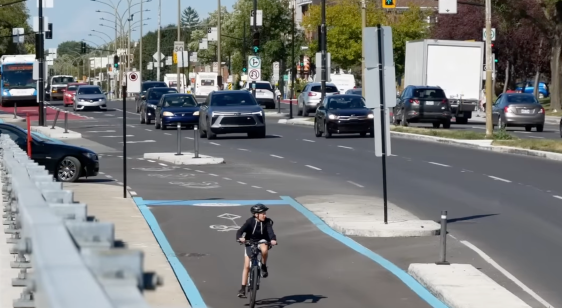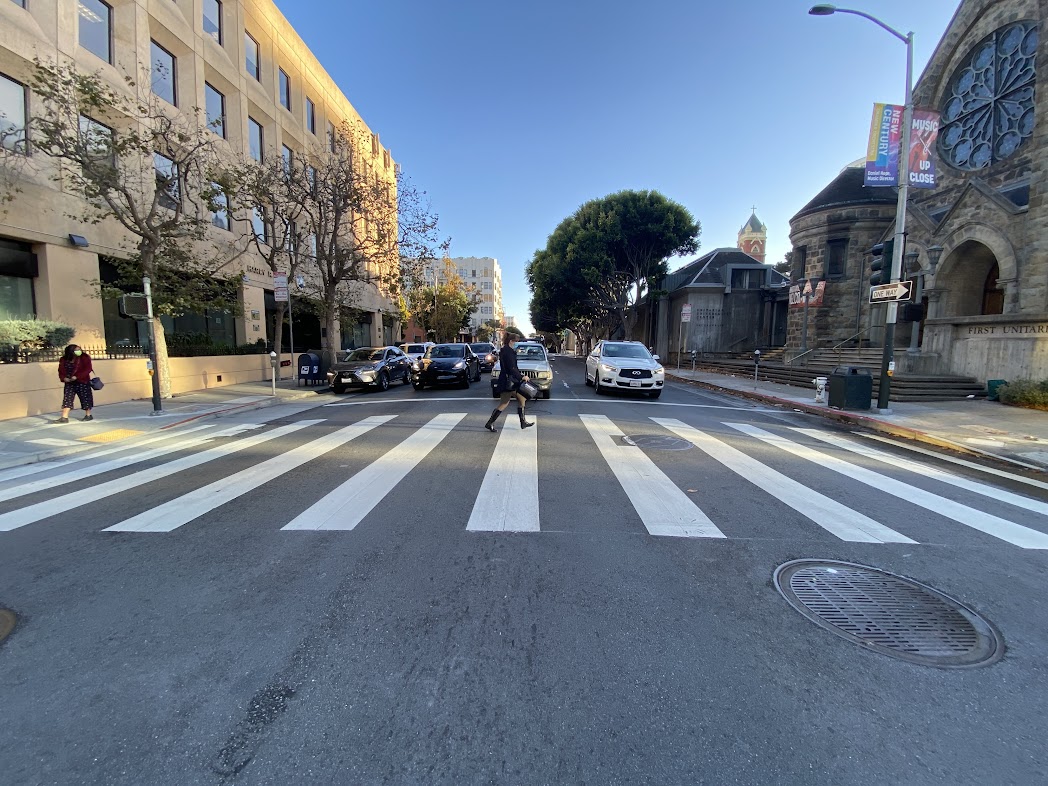Caltrans needs to stop focusing so much on moving cars and let cities build safer street designs with protected bike lanes, says a new report commissioned by Governor Jerry Brown and CA Transportation Secretary Brian Kelly.

The report [PDF] calls out Caltrans' "archaic" practices when it comes to imposing outdated, automobile-centric design standards on city streets in California, and says the department should reform its "culture of risk aversion and even fear," which often prevents local city planners from implementing modern designs for bicycle- and pedestrian-friendly streets.
When agencies like the SF Municipal Transportation Agency want to implement protected bike lanes, they must take a legal risk since Caltrans hasn't approved such designs, and design exceptions require "a painful and time-consuming process," says the report, produced by the State Smart Transportation Initiative.
"Caltrans’ peculiar standards on bicycle facilities even pertain to locally owned streets, precluding some active transportation initiatives," the report says. "The agency and department should support, or propose if no bill is forthcoming, legislation to end the archaic practice of imposing state rules on local streets for bicycle facilities."
In a statement, TransForm said the report "offers a refreshingly candid and detailed critique, and more importantly points to a host of critical reforms."
"The report recommends the direction come 'from the top down and outside in,' to avoid the long-standing status quo at Caltrans where bottom-up planning via staff just leads to 'the culture endorsing itself,'" said TransForm.
Stuart Cohen, TransForm's executive director and a member of Secretary Kelly's CA Transportation Infrastructure Priorities workgroup, said that "this is not the first report slamming Caltrans" but that the critical difference comes from the "tremendous leadership" of Governor Brown and Kelly, who commissioned the review.
“We asked for an honest assessment because we are committed to modernizing Caltrans and improving transportation for all Californians,” Kelly said in a statement.
Caltrans Director Malcolm Dougherty issued a statement saying that "we see this as a tremendous opportunity to reassess our priorities and improve our performance."
"We have some internal reforms already underway so we can hit the ground running," he said.
Although Caltrans has issued reports acknowledging the need to re-calibrate its approach to favor non-automotive travel in cities, implementing the culture change has proven to be easier said than done. The report notes that "one senior staff member... told us that bicycle and pedestrian facilities are not part of Caltrans’ mission."
"Most of the recommendations are not simple check-the-box action items, but calls for hard work of collaborating, rethinking and establishing a new course," said SSTI reviewers.
Seleta Reynolds, section leader for the SFMTA's Livable Streets Division, told People for Bikes it's about time that Caltrans adapt to the transportation practices of the 21st century. "When Caltrans first put in the requirement that cities follow their Highway Design Manual for bikeways, even on local streets, it was for good reason," she said. "The state of the practice around designing for bikes was just developing, and it was a reliable way to make sure that people wouldn’t build sub-standard facilities. These days, though, that need no longer exists."
So far, the SFMTA has taken some bold steps in challenging Caltrans standards with protected bike lanes, as CA Bike Coalition Executive Director Dave Snyder told the SF Bay Guardian yesterday. “San Francisco is technically breaking the law because they have the best traffic engineers in the state and a good City Attorney’s Office and they know they can defend it in court if they have to," Snyder said. "Most places in the state won’t do that."
CalBike is backing Assemblymember Phil Ting's AB 1193, "which would legalize and set design standards for cycletracks," according to the Bay Guardian. The bill cleared the Assembly on Wednesday and next goes to the Senate.
The SSTI report recommends some initial steps for Caltrans to get out of the way of municipalities who want to implement modern designs:
- Caltrans should relinquish oversight of bike facilities on locally owned streets.
- Caltrans should give designers the option of using NACTO urban design standards in metro areas. (The SFMTA formally adopted the NACTO guide as a reference manual last week.)
- Caltrans should generally rethink its approach to facilities in metro areas and town centers.
California's state DOT, the report says, needs to realize that the approach to designing highways doesn't make any sense in cities:
Caltrans grew up with the idea it was moving travelers between cities, but now most of its facilities provide access between local destinations ... The policies and standards in metro areas and towns should be very different than those for facilities in low-density rural areas; where the latter may legitimately focus on speed and throughput of motor vehicles (though not to the extent that they induce new travel and low-density development), the former should put pedestrian, bicyclist and livability concerns before auto-mobility. Narrower lanes, slower speeds, and pedestrian amenities should all be the default.





